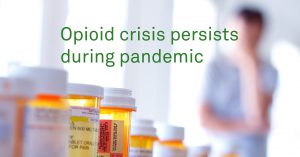 He’s down to his last Vicodin. His chronic pain pushes him to visit a second doctor to get more painkillers to ease his agony. She sympathizes with her exhausted neighbor and shares some pills to bring sleep back to her restless nights. Just as her husband suffers from a knee injury after a pickup basketball game, she remembers the leftover pills from the birth of baby number three in the back of the cabinet. These are common scenarios because when we feel pain, we want it to go away. But, the misuse of prescriptions remains at the center of our nation’s opioid epidemic.
He’s down to his last Vicodin. His chronic pain pushes him to visit a second doctor to get more painkillers to ease his agony. She sympathizes with her exhausted neighbor and shares some pills to bring sleep back to her restless nights. Just as her husband suffers from a knee injury after a pickup basketball game, she remembers the leftover pills from the birth of baby number three in the back of the cabinet. These are common scenarios because when we feel pain, we want it to go away. But, the misuse of prescriptions remains at the center of our nation’s opioid epidemic.
Misuse occurs when a prescribed drug is taken in a way that is not consistent with a physician’s orders. For many, deviating from a doctor’s instructions may lead to dependence on painkillers and, in the worst case scenario, seeking out to find street drugs like heroin or fentanyl when the refills run out. The National Institute on Drug Abuse has mounting research showing that many people switch from prescription opioids to heroin because of easier access, lower prices, and greater purity.
The government and scientific communities are studying what has become our fastest-growing drug problem since the explosion of crack cocaine in the early 1980s. Their work seeks solutions to a crisis that impacts millions of lives every day. In an effort to centralize the latest news, we have compiled headlines and data about substance abuse, addiction, overdose deaths, and the health consequences of our country’s opioid epidemic.
- The National Safety Council (NSC) identified prescription drug misuse as a key issue because the epidemic affects 7 in 10 U.S. employers. Data from the NSC shows that 41% of employers do not currently drug test for synthetic opioids.
- Opioid users miss twice as many days of work as people with addictions to other drugs. An employee with a pain medicine disorder misses an average of 29 days in a year compared to 14 days missed due to alcohol abuse, according to National Public Radio (NPR).
- Opioid use by American men may account for a 20% decline in their participation in the U.S. labor force, according to a study by Princeton University looking at 15 years of data. The economist says “nearly half of men in their prime worker ages not in the labor force take prescription painkillers daily.”
- Half of Americans (52%) tested in a recent Quest Diagnostics Health Trends study misused their prescription medications. The study also found dangerous drug combinations of opioids, benzodiazepines, and alcohol are common.
- Overall positivity rates for heroin increased 146% between 2011 and 2015 in the general U.S. workforce, according to the Quest Diagnostics Drug Testing Index™.
- A study in the Journal of the American Medical Association estimated that opioids are shortening the life span of Americans by 2½ months.
- A report from Pacira Pharmaceuticals said middle-aged women (aged 40 to 59 years old) are prescribed more opioids than other groups and twice as many as men in their same age group. Mostly prescribed post-surgery, these group accounts for 3.3 billion unused pills.
- CVS became the first national pharmacy chain to limit opioid prescriptions to 7 days for certain conditions. The restriction also applies to patients who are new to pain therapy. Also, Cigna announced that it will not cover the opioid OxyContin for customers who are insured through a job, starting in 2018.
- Many lawmakers are working on legislation to help. One example is Rick Scott, the governor of Florida, who proposed a three-day limit on prescribed opioids in his state. Many states control the substances that are dispensed using an electronic database in a prescription drug monitoring program.
- According to the Centers for Disease Control and Prevention (CDC), “sales of prescription opioids nearly quadrupled from 1999 to 2014, but there has not been an overall change in the amount of pain Americans report.”
Despite the resources available to increase awareness and help those struggling with substance use disorders, current statistics show that the crisis is far from over. Drug overdose is now the leading cause of accidental death among Americans under age 50 and researchers may have even underestimated overdose deaths this year with the loss of life trending to reach a record high.
To learn more about drug testing, visit our website.
 Your Privacy Choices
|
Privacy Notices
|
Terms
|
Language Assistance / Non-Discrimination Notice | Asistencia de Idiomas / Aviso de no Discriminación | 語言協助 / 不䈚視通知
Your Privacy Choices
|
Privacy Notices
|
Terms
|
Language Assistance / Non-Discrimination Notice | Asistencia de Idiomas / Aviso de no Discriminación | 語言協助 / 不䈚視通知


















Misuse occurs when a prescribed drug is taken in a way that is not consistent with a physician’s orders. For many, deviating from a doctor’s instructions may lead to dependence on painkillers and, in the worst case scenario, seeking out to find street drugs like heroin or fentanyl when the refills run out. The National Institute on Drug Abuse has mounting research showing that many people switch from prescription opioids to heroin because of easier access, lower prices, and greater purity.
The government and scientific communities are studying what has become our fastest-growing drug problem since the explosion of crack cocaine in the early 1980s. Their work seeks solutions to a crisis that impacts millions of lives every day. In an effort to centralize the latest news, we have compiled headlines and data about substance abuse, addiction, overdose deaths, and the health consequences of our country’s opioid epidemic.
Despite the resources available to increase awareness and help those struggling with substance use disorders, current statistics show that the crisis is far from over. Drug overdose is now the leading cause of accidental death among Americans under age 50 and researchers may have even underestimated overdose deaths this year with the loss of life trending to reach a record high.
To learn more about drug testing, visit our website.